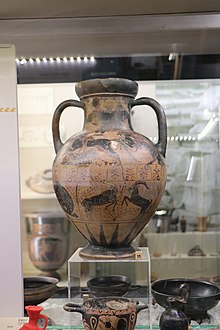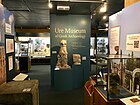
In Greek mythology, Polyxena was the youngest daughter of King Priam of Troy and his queen, Hecuba. She does not appear in Homer, but in several other classical authors, though the details of her story vary considerably. After the fall of Troy, she dies when sacrificed by the Greeks on the tomb of Achilles, to whom she had been betrothed and in whose death she was complicit in many versions.
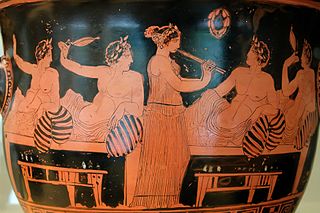
In Ancient Greece, the symposium was a part of a banquet that took place after the meal, when drinking for pleasure was accompanied by music, dancing, recitals, or conversation. Literary works that describe or take place at a symposium include two Socratic dialogues, Plato's Symposium and Xenophon's Symposium, as well as a number of Greek poems such as the elegies of Theognis of Megara. Symposia are depicted in Greek and Etruscan art that shows similar scenes.

Black-figure pottery painting, also known as the black-figure style or black-figure ceramic, is one of the styles of painting on antique Greek vases. It was especially common between the 7th and 5th centuries BCE, although there are specimens dating as late as the 2nd century BCE. Stylistically it can be distinguished from the preceding orientalizing period and the subsequent red-figure pottery style.

Exekias was an ancient Greek vase painter and potter who was active in Athens between roughly 545 BC and 530 BC. Exekias worked mainly in the black-figure technique, which involved the painting of scenes using a clay slip that fired to black, with details created through incision. Exekias is regarded by art historians as an artistic visionary whose masterful use of incision and psychologically sensitive compositions mark him as one of the greatest of all Attic vase painters. The Andokides painter and the Lysippides Painter are thought to have been students of Exekias.

Troilus is a legendary character associated with the story of the Trojan War. The first surviving reference to him is in Homer's Iliad, composed in the late 8th century BCE.
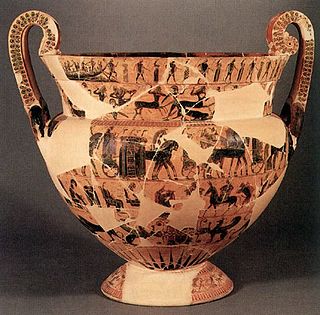
The François Vase is a large Attic volute krater decorated in the black-figure style. It stands at 66 cm in height and was inspired by earlier bronze vases. It was used for wine. A milestone in the development of ancient Greek pottery due to the drawing style used as well as the combination of related stories depicted in the numerous friezes, it is dated to circa 570/560 BCE. The François Vase was discovered in 1844 in Chiusi where an Etruscan tomb in the necropolis of Fonte Rotella was found located in central Italy. It was named after its discoverer Alessandro François, and is now in the Museo Archeologico in Florence. It remains uncertain whether the krater was used in Greece or in Etruria, and whether the handles were broken and repaired in Greece or in Etruria. The François Vase may have been made for a symposium given by a member of an aristocratic family in Solonian Athens, then broken and, after being carefully repaired, sent to Etruria, perhaps as an instance of elite-gift exchange. It bears the inscriptions Ergotimos mepoiesen and Kleitias megraphsen, meaning 'Ergotimos made me' and 'Kleitias painted me'. It depicts 270 figures, 121 of which have accompanying inscriptions. It is highly unusual for so many to be identifiable: the scenes depicted represent a number of mythological themes. In 1900 the vase was smashed into 638 pieces by a museum guard by hurling a wooden stool against the protective glass. It was later restored by Pietro Zei in 1902, followed by a second reconstruction in 1973 incorporating previously missing pieces.

The Staatliche Antikensammlungen is a museum in Munich's Kunstareal holding Bavaria's collections of antiquities from Greece, Etruria and Rome, though the sculpture collection is located in the opposite Glyptothek and works created in Bavaria are on display in a separate museum. Ancient Egypt also has its own museum.

Etruscan art was produced by the Etruscan civilization in central Italy between the 10th and 1st centuries BC. From around 750 BC it was heavily influenced by Greek art, which was imported by the Etruscans, but always retained distinct characteristics. Particularly strong in this tradition were figurative sculpture in terracotta, wall-painting and metalworking especially in bronze. Jewellery and engraved gems of high quality were produced.
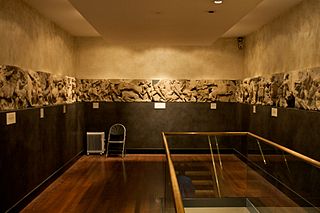
The Bassae Frieze is the high relief marble sculpture in 23 panels, 31 m long by 0.63 m high, made to decorate the interior of the cella of the Temple of Apollo Epikourios at Bassae. It was discovered in 1811 by Carl Haller and Charles Cockerell, and excavated the following year by an expedition of the Society of Travellers led by Haller and Otto von Stackelberg. This team cleared the temple site in an endeavour to recover the sculpture, and in the process revealed it was part of the larger sculptural programme of the temple including the metopes of an external Doric frieze and an over-life-size statue. The find spots of the internal Ionic frieze blocks were not recorded by the early archaeologists, so work on recreating the sequence of the frieze has been based on the internal evidence of the surviving slabs and this has been the subject of controversy.

The Archaeological Museum of Eretria is a museum in Eretria, in the Euboea regional unit of Central Greece.

The Etruscans, like the contemporary cultures of Ancient Greece and Ancient Rome had a persistent military tradition. In addition to marking the rank and power of certain individuals in Etruscan culture, warfare was a considerable economic boon to Etruscan civilization. Like many ancient societies, the Etruscans conducted campaigns during summer months; raiding neighboring areas, attempting to gain territory and combating piracy as a means of acquiring valuable resources such as land, prestige goods and slaves. It is also likely individuals taken in battle would be ransomed back to their families and clans at high cost. Prisoners could also potentially be sacrificed on tombs to honor fallen leaders of Etruscan society, not unlike the sacrifices made by Achilles for Patroclus.

Perseus Freeing Andromeda is a painting by the Flemish artist Peter Paul Rubens, done in 1622. It is now in the Gemäldegalerie, Berlin, Germany.

The Pontic Group is a sub-style of Etruscan black-figure vase painting.

The Tomb of the Bulls is an Etruscan tomb in the Necropolis of Monterozzi near Tarquinia, Lazio, Italy. It was discovered in 1892 and has been dated back to either 540–530 BC or 530–520 BC. According to an inscription Arath Spuriana apparently commissioned the construction of the tomb. It is named after the two bulls which appear on one of its frescoes. It is the earliest example of a tomb with complex frescoes in the necropolis, and the stylistic elements are derived from Ionian Greek culture. Along with the frescoes of the Tomb of the Whipping these paintings are relatively rare examples of explicit sexual scenes in Etruscan art, which were far more common in Ancient Greek art.

The Judgement of Paris Amphora is an Attic black-figure amphora named for the scene depicted on it. It is held by the Musée des beaux-arts de Lyon with the inventory number E 581-c and is attributed to the London B76 Painter, who was active at Athens in the second quarter of the sixth century BC.
The Neck Amphora by Exekias is a neck amphora in the black figure style by the Attic vase painter and potter Exekias. It is found in the possession of the Antikensammlung Berlin under the inventory number F 1720 and is on display in the Altes Museum. It depicts Herakles' battle with the Nemean lion on one side and the sons of Theseus on the other. The amphora could only be restored for the first time almost a hundred and fifty years after its original discovery due to negligence and political difficulties.

The Amphora of Hermonax in Würzburg is a neck amphora which was made by the early classical Attic vase painter Hermonax in the red figure style of Greek vase painting around 450 BC. The amphora was found in an Etruscan grave in Vulci. Originally kept in the Feoli collection, it now belongs to the antiquity collection of the Martin von Wagner Museum in Würzburg, where it is on display with a lid which probably does not belong to it.
This two-sided, red figure belly amphora is housed in the Classics wing of the Museum of Fine Arts, Boston. It was bought during Art Basel from Münzen und Medaillen, A.G., October 17, 1963. With flat handles decorated with depictions of ivy, and a double layered foot, it qualifies as a type A amphora. Dated circa 510 BCE, it was likely created by a member of the circle of Euthymides in Athens. It is an early example of red-figure pottery which had been invented only ten years previously. It is regarded by scholars as one of the best examples of the vases that influenced artists in Etruria. It is in excellent condition, but lacks an original find-spot.

The Reading Aulos is the surviving half of an ancient Greek aulos. It is much more complete than other examples found to date, and is on permanent display at the Ure Museum of Greek Archaeology in Reading, England.
